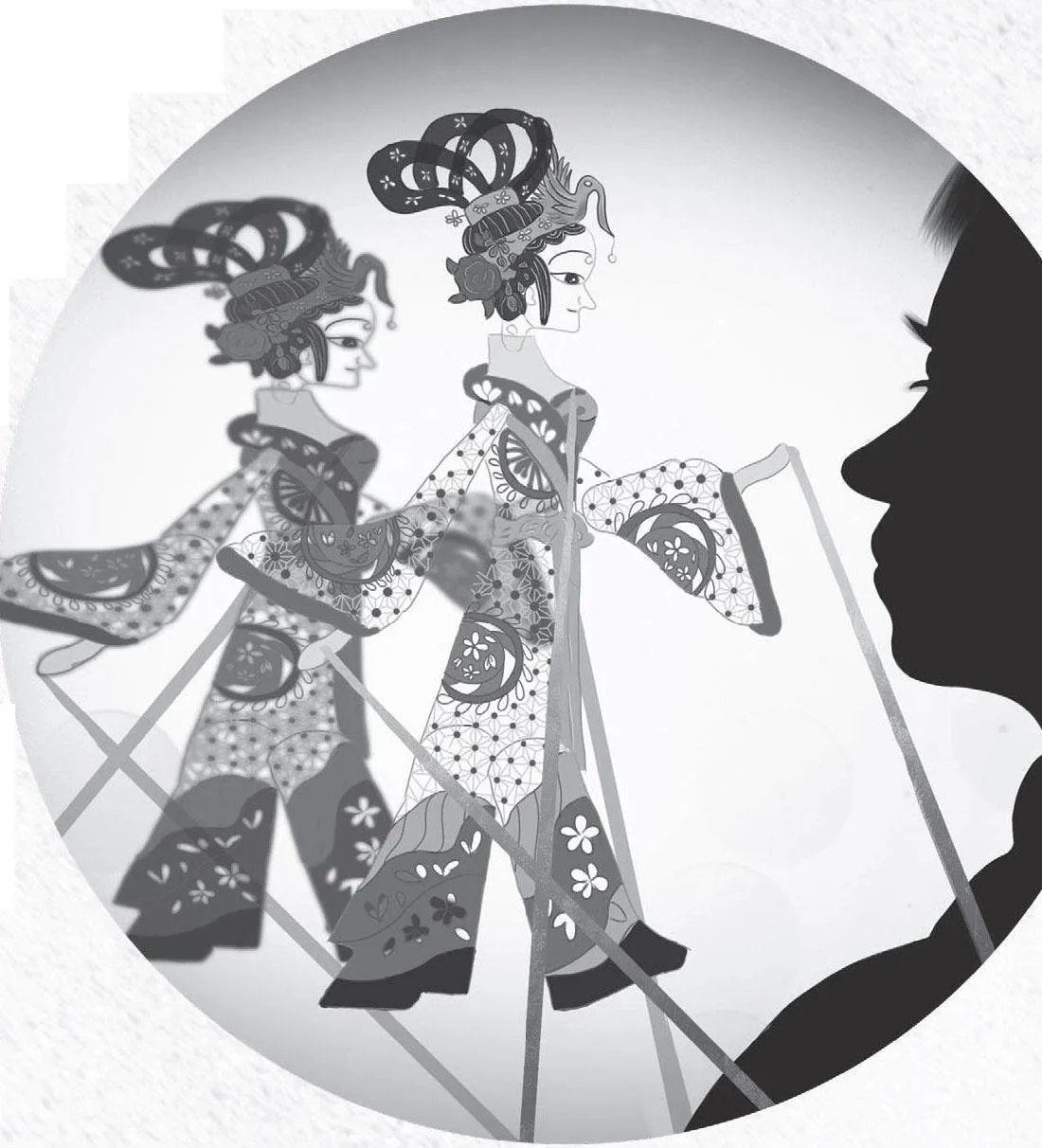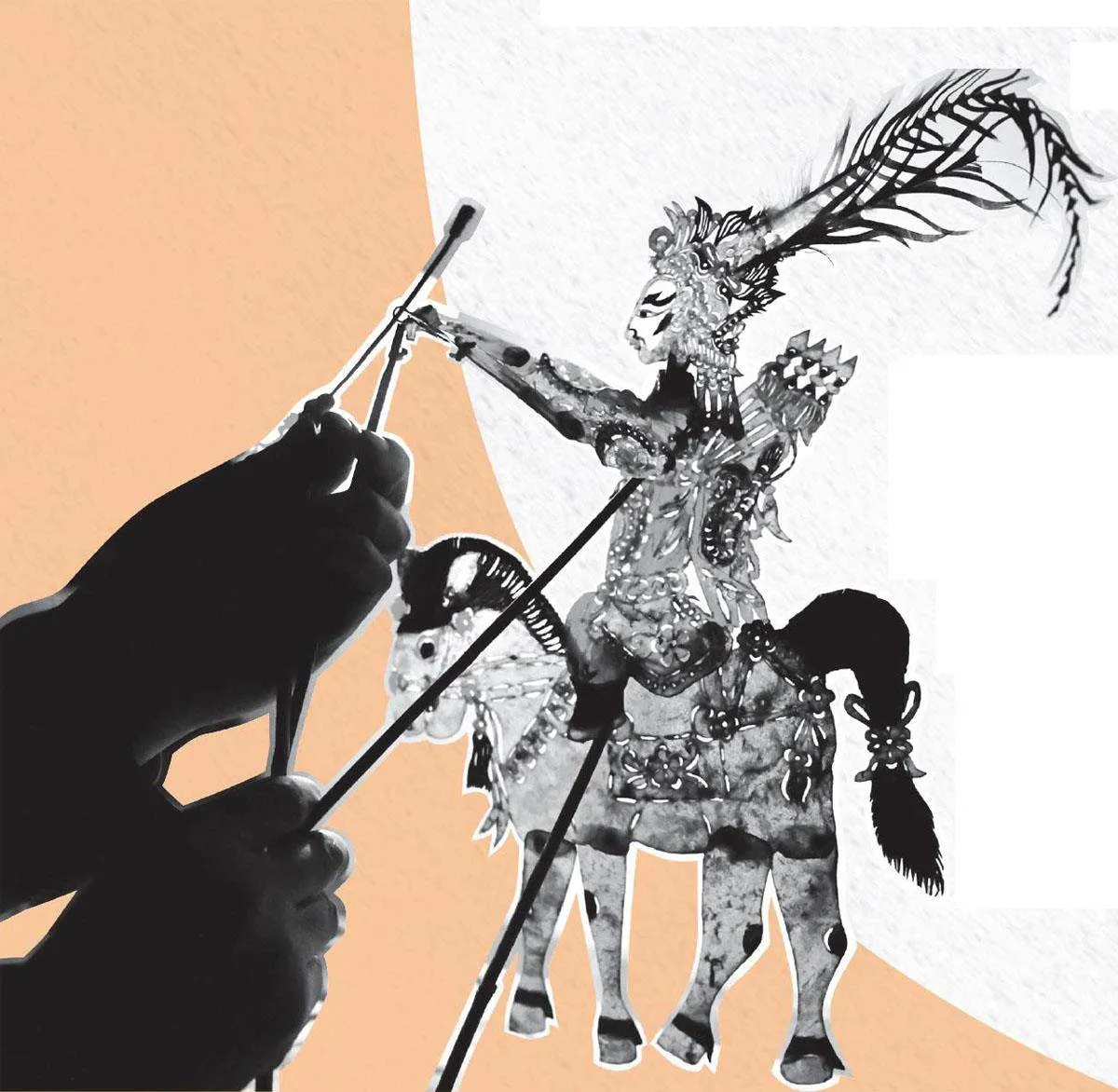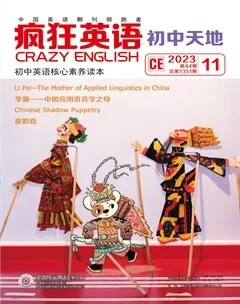Chinese Shadow Puppetry中国皮影戏




一块幕布、一点光源、两张方桌、五人戏班。幕布上,几张皮影在皮影艺人的操控下,演绎人间悲喜以及传说。皮影戏是中国古老而精妙的民间传统艺术,也是中国传统文化的“活化石”。
Chinese shadow puppetry, also known as “lamp shadow play”, isan ancient and 1)exquisite traditional folk art form and renowned forits unique imagery and storytelling. The principles of curtain shadingand performance forms adopted by Chinese shadow puppetryplayed a significant role in the invention and development of modernmovies. In 2011, Chinese shadow puppetry was listed as UNESCO’sRepresentative List of the Intangible Cultural Heritage of Humanity.
The history of Chinese shadow puppetry in China can be tracedback over two thousand years. It originated in the northern part ofChina, particularly in the province of Shaanxi, and later spread widelyacross the country. It was often performed at temple fairs, weddingceremonies, funeral ceremonies, and other special occasions. Peoplebelieved that the performance of Chinese shadow puppetry woulddrive out evil spirits and bring them good fortune.
It is said that Chinese shadow puppetry first appeared in theWestern Han Dynasty. When Emperor Wu of the Han Dynasty’sbeloved 2)concubine, Li, passed away, he was deeply saddened andneglected his governmental duties. One day, Shaoweng encountereda child playing with a doll, and its shadow was reflected on the ground,appearing lifelike. Inspired, Shaoweng cut out Li’simage from cotton and silk, painted it, andattached wooden poles to its hands andfeet. At night, a square curtain was setup, and lights and candles were lit.Emperor Wu of the Han Dynastywas respectfully invited to watchthe performance. He was delightedand became fond of it. This lovestory, recorded in the Hanshu,is considered the earliest origin ofChinese shadow puppetry.
The main objects of Chinese shadow puppetry are theshadow puppets themselves, which are intricately carvedout of leather. Initially, shadow puppets were made frompaper sculptures and later from hides. These puppets arethen projected onto a screen using light, creating vivid andlifelike images. This is why shadow puppetry is called piyingin Chinese. Each puppet is 3)meticulously crafted, depictingvarious characters. By hanging these puppets behind ascreen and 4)illuminating them with light, performers bring thecharacters to life through their 5)manipulations and techniques.Chinese shadow puppetry is often accompanied by music andsinging, enhancing its dramatic and artistic appeal. Over time,this art form has been improved and developed.
The stories performed in Chinese shadow puppetry 6)encompass a widerange of content, includingmythology, legends, history,and folk tales. These storiesoften carry profound cultural connotationsand moral messages, conveying wisdomand values through their narratives.Thus, Chinese shadow puppetry notonly entertains the audience but alsoinspires their thinking.
For centuries, Chinese shadowpuppetry has provided the people with countless joyfulmoments, showcasing a rich variety of stories and culturalconnotations. By appreciating and understanding Chineseshadow puppetry, we can gain a deeper understanding oftraditional Chinese art and cultural heritage.
1) exquisite adj. 精美的
2) concubine n. 妃子
3) meticulously adv. 细致地;一丝不苟地
4) illuminate v. 点亮;照明
5) manipulation n. 操作
6) encompass v. 围绕;包含
中国皮影戏,又称“灯影戏”,是一种古老而精妙的传统民间艺术,以其独特的影像和故事闻名于世。中国皮影戏所用的幕影原理及表演形式,对近代电影的发明和发展起到了重要的作用。2011 年,中国皮影戏入选联合国教科文组织《人类非物质文化遗产代表作名录》。
中国皮影戏的历史可追溯到两千多年前。它起源于中国北方,尤其是陕西地区,后来在全国范围内广泛流传开来。中国皮影戏经常出现在庙会、婚礼、葬礼以及其他特殊场合。人们认为皮影戏能驱邪并给他们带来好运。
相传,中国皮影戏最早出现于西汉。汉武帝爱妃李夫人故去,他陷入悲伤中,终日不理朝政。绍翁一日出门,路遇孩童手拿布娃娃玩耍,影子倒映于地栩栩如生。绍翁心中一动,用棉帛、丝绸裁成李夫人的形象,涂上色彩,并在手脚处装上木杆。入夜围方帷,张灯烛,绍翁恭请汉武帝端坐帐中观看。汉武帝看后喜笑颜开,就此爱上皮影戏。这个载入《汉书》的爱情故事,被认为是中国皮影戏最早的起源。
中国皮影戏表演的主要道具是由传统的皮革雕刻而成的影偶。影偶刚开始用纸雕,后来用兽皮制作。人们利用灯光将这些影偶投射在幕布上,创造出生动逼真的形象。这就是为什么汉语称之为“皮影”。每个皮影都经过精细剪裁,描绘了各种各样的角色。将这些皮影悬挂在幕布后面,并使用灯光照射,皮影艺人通过手法和技巧,使角色栩栩如生地展现在观众面前。中国皮影戏通常伴随着音乐和歌唱,增加了戏剧性和艺术感。随着时间的推移,这一艺术形式得到了改进和发展。
中国皮影戏的故事内容丰富多样,涵盖了神话、传说、历史和民间故事等。这些故事常常具有深厚的文化内涵和道德寓意,在讲述中传递着智慧和价值观。因此,中国皮影戏不仅能给观众带来欢乐,还能够给观众以启迪。
千百年来,中国皮影戏给祖祖辈辈的人带来了许多欢乐的时光,展现了丰富多样的故事和文化内涵。通过欣赏和了解中国皮影戏,我们可以更好地理解中国的传统艺术和文化遗产。

